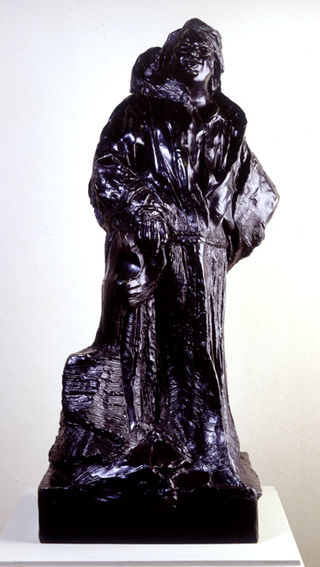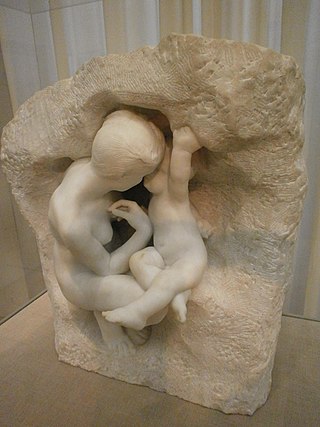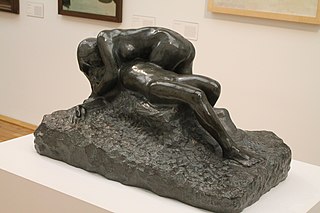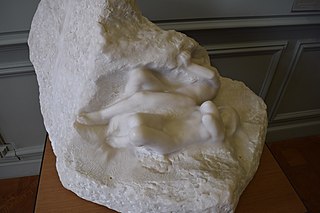
François Auguste René Rodin was a French sculptor, generally considered the founder of modern sculpture. He was schooled traditionally and took a craftsman-like approach to his work. Rodin possessed a unique ability to model a complex, turbulent, and deeply pocketed surface in clay. He is known for such sculptures as The Thinker, Monument to Balzac, The Kiss, The Burghers of Calais, and The Gates of Hell.

Camille Rosalie Claudel was a French sculptor known for her figurative works in bronze and marble. She died in relative obscurity, but later gained recognition for the originality and quality of her work. The subject of several biographies and films, Claudel is well known for her sculptures including The Waltz and The Mature Age.

The Gates of Hell is a monumental bronze sculptural group work by French artist Auguste Rodin that depicts a scene from the Inferno, the first section of Dante Alighieri's Divine Comedy. It stands at 6 metres high, 4 metres wide and 1 metre deep (19.7×13.1×3.3 ft) and contains 180 figures.

The Age of Bronze is a bronze statue by the French sculptor Auguste Rodin (1840–1917). The figure is of a life-size nude male, 72 in. (182.9 cm) high. Rodin continued to produce casts of the statue for several decades after it was modelled in 1876.

The Walking Man is a bronze sculpture by the French sculptor Auguste Rodin. This sculpture was made in 1907.

Brother and Sister is an 1890 bronze sculpture by Auguste Rodin.

The Prodigal Son is a sculpture by Auguste Rodin.

Balzac in the Robe of a Dominican Monk is a bronze sculpture by French artist Auguste Rodin, one of the studies made in preparation to the Monument to Balzac, a tribute to novelist Honoré de Balzac commissioned by the Society of Men of Letters of France in 1891.

Fugitive Love is a sculpture by Auguste Rodin made between 1886 and 1887, both sculpted in marble and cast in bronze. It represents a man and a woman embracing each other on top of a rock. More specifically, the author was inspired by the story of Francesca da Rimini's love affair with Paolo Malatesta, an allusion to Dante Alighieri's depiction of lust on the second circle of Hell in his Inferno.

Pierre de Wissant is a bronze sculpture by French artist Auguste Rodin, part of his sculptural group The Burghers of Calais. This sculpture represents one of the six burghers who, according to Jean Froissart surrendered themselves in 1347, at the beginning of the Hundred Years' War (1337–1453), in order to save the inhabitants of the French city of Calais from the English laying siege to the city.

The Three Shades is a sculptural group produced in plaster by Auguste Rodin in 1886 for his The Gates of Hell. He made several individual studies for the Shades before finally deciding to put them together as three identical figures gathered around a central point. The heads hang low so that the neck and shoulders form an almost-horizontal plane. They were to be placed above the gates looking down on the viewer.

Adonis Awakens is an 1889 sculpture by the French artist Auguste Rodin. Based on the account of Adonis in Book 10 of Ovid's Metamorphoses, it is signed “A RODIN” on the edge of the base. It is now in the Museo Soumaya in Mexico City.

Young Mother in the Grotto or Woman and Love is a sculpture by Auguste Rodin, conceived in plaster around 1885. It was first exhibited at the Paris Salon of 1885. John Tweed was very close to Rodin and Young Mother was a strong influence on his 1894 Mother and Child.

The Death of Adonis is a white marble sculpture. It was created by Auguste Rodin and signed “A RODIN” on the base. It shows Aphrodite mourning over the body of Adonis. The main version is in the Musée Rodin and another is in the Museo Soumaya.

Ovid's Metamorphoses or The Satyrs is a sculpture by Auguste Rodin, created as part of The Gates of Hell.

Polyphemus is an 1888 sculpture by Auguste Rodin, showing Polyphemus and his love for the Nereid Galatea, as told in Book XIII of Ovid's Metamorphoses.

Adam and Eve or Adam and Eve Sleeping is a 1905 marble sculpture by Auguste Rodin. It is located in the Musee Rodin in France.

Adam is an 1880-1881 statue of Adam by Auguste Rodin, first exhibited at the Paris Salon that year entitled The Creation of Man.


















